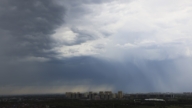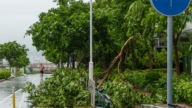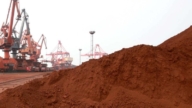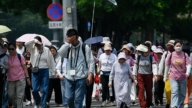【新唐人2013年03月15日讯】世界气象组织专家经过多年观测发现,被称作“世界屋脊”的青藏高原地区,有85%至90%的冰川正在急剧融化,严重威胁未来数十亿人的生活与生产。下面请一起来了解这个现象。
3月13号,世界气象组织主办的“极地观测、研究与服务”会议,在中国大陆的甘肃省省会兰州召开。专家组成员、中国科学院“寒区旱区环境与工程研究所”研究员效存德在会上说,中国从80年代加入所谓“极区”观测和研究的行列,经过多年的观测显示,地球的“第三极”——青藏高原地区,85%至90%的冰川在退缩。
与会者之一——中国大陆的气象局副局长徐小峰说,“第三极”正在显着变暖,加剧冰雪融化,严重威胁未来数十亿人的生活。
“第三极”是以青藏高原为中心,西起帕米尔高原和兴都库甚山脉,东到横断山脉,北起昆崙山和祁连山,南到喜玛拉雅山脉。共有10万平方公里的冰川,是长江、黄河、恒河等10多条亚洲大江大河的源区。
早在2005年,“青藏高原生态地质环境遥感调查与监测”项目,专家组的调查结果已显示,青藏高原生态环境在30年间,出现了明显恶化的趋势:大面积冰川消退,平均每年减少147.36平方公里。鉴于青藏高原多个冰川雪线不断上移,预料2090年冰川总面积将只剩50%。
关注环境保护的北京维权人士胡佳表示,2005年他去青藏高原的时候,发现那边冰川确实在大面积退缩。
北京维权人士胡佳:“我们在西藏高原可可西里那边,开车行进的时候,我们居然行进在大片的湖底,就原来是一片湖,昆明山那边的王母瑶池,我们当时就在它那边大片的湖,干涸了,在那个湖底下,这个退化在过去的十年来讲是相当明显的。”
北京环保自愿者张俊峰指出,近100年以来,全球气候温度整体上升。
北京环保自愿者张俊峰:“上升的结果,就使得雪线从原来的2000米左右,一直上升到现在的距离(水平面)3000米。就使得大量的低于3000米以下的积雪和冰川发生融化,这种融化的结果还有一个潜在的现象是,使得地球大气里面的水汽结露点的海拔高度也跟着上升了,那么就使得很多地区原来的泉水消失了,这也是造成了现在的水资源缺乏的这么一个根源。”
张俊峰还表示,人类的农业系统依靠稳定的气候系统支撑,气候系统一旦发生极端变化,将会造成农业发生大面积的减产。张俊峰预测,未来非常可能出现这个状况。
张俊峰:“另外的方面就是植被,生态系统受很大影响,会使得整个地球生态系统原来储存能量、转换能量的功能减弱,会使得地球全球变化的状态变得越来越恶化,也就进入到一种恶性循环里面去,也是把这个平衡点打破了,人类可能遭受自然灾害的状况会越来越频繁。”
此外,气候变暖还有一个最大的威胁,就是大面积冰川融化导致的海平面上升。据预测,如果平均气温上升1.5至4.5摄氏度,海平面将上升25至100厘米。海平面上升后,除了淹没沿海低地外,海底地震和海洋风暴也会随之增加,海洋潮汐也将发生变化。这些变化,将直接影响到沿海60千米范围内,数十亿人的社会经济活动,世界上30%的大城市,将受到海潮的威胁,许多岛屿将从地图上消失。
去年11月中旬,世界银行发布一份科研报告说,如果国际社会不采取措施抑制气候变化,到本世纪末,全球气温将会升高4度,引发一连串的灾难性,包括极端热浪、全球粮食库存下降、海平面上升、珊瑚礁死亡等,全世界各个地区将无一幸免。
采访编辑/李韵 后制/郭敬
Qinghai-Tibet Glaciers Quick Melting Threatens Billions of Chinese
Experts of the World Meteorological Organization found
that after years of observation, 85-90% of the glaciers
are rapidly melting in the Qinghai-Tibet Plateau region,
which is known as “the roof of the world.”
This will become a serious threat to billions of people’s lives.
Let’s understand this phenomenon together.
On March 13th, a meeting regarding “Polar Observations,
Research and Services” organized by the
World Meteorological Organization was held in Lanzhou,
capital of Gansu Province.
Xiao Chengde, researcher at the Chinese Academy
of Sciences, said at the meeting that
China has joined the observation and study of the
so-called polar regions since 1980.
After years of observation, it shows that 85-90% of
glaciers in the Earth’s “Third Pole", Qinghai-Tibet Plateau region, is rapidly melting.
Xu Xiaofeng, Deputy Secretary of China Meteorological
Bureau, said the third pole is warming noticeably, which
exacerbates snow melting and threaten the lives of
billions of people in the future.
The third pole is based at the Qinghai-Tibet Plateau,
the west Pamir and Hindu Kush mountain range,
east of the Hengduan Mountains, north of the Kunlun
Mountains and Qilian Mountains, and south of the Himalayas.
A total of 100,000 square kilometers of glaciers is the source
of more than 10 major rivers in Asia, including the Yangtze River, the Yellow River, and the Ganges.
As early as in 2005, the ecological geological survey showed
that a marked deterioration occurred in the last 30 years in the Qinghai-Tibet Plateau’s ecological environment.
A large area of the glaciers receded, at the average reduction
of 147.36 square kilometers per year.
In view of the Qinghai-Tibet Plateau glacier snow line,
only 50% of the total glacial area will be left by 2090.
Hu Jia, environmental protection activist in Beijing, said,
when he went to the Tibetan Plateau in 2005, that he saw glaciers in a large area having retreated.
Hu Jia: “When traveling by car in Hoh Xil
of the Tibetan plateau, we actually drove in a large area—
the bottom of the Queen-Mother-Jade-Pound.
We were at a huge lake area, which had totally dried up.
The environmental degradation in the past decade
was quite obvious."
Zhang Junfeng, Beijing environmental protection volunteer,
pointed out that in the last 100 years, the overall global climate has increased.
Zhang Junfeng: “The global warming caused the snow line
to move up, from the 2000 meter mark above sea level to 3,000 meters.
Thus, a large amount of glaciers below 3,000 meters
started to melt.
In addition, the glacier-melting results in the rising altitude
of water vapor inside the Earth’s atmosphere.
Thus, many springs have disappeared and caused
water shortage nowadays.”
Zhang Junfeng commented that human agricultural systems
depend on a stable climate.
Once the climate system shows an extreme change, a decrease
in agricultural productions over a large area can take place.
Zhang predicts this would likely happen in the future.
Zhang Junfeng: “The vegetation and ecosystem would
also be seriously affected.
It weakens the functions of the original energy storage
and energy conversion of the entire planet.
It will worsen the Earth’s global change condition and
turn into a vicious cycle.
Once this balance point is broken, human beings would
encounter more natural disasters.”
The biggest threat of climate warming is that a large area
of glaciers melts and causes a rising sea level.
It is predicted that, if the average temperature increases from
1.5 to 4.5 degrees Celsius, the sea level will rise 25-100cm.
A sea level rise not only floods coastal lowlands, but also
affects the undersea earthquake, ocean storms and ocean tides.
These changes will have a direct impact on cities within
60 kilometers of the coast and socio-economic activities of billions of people.
30% of the world’s major cities will be subject to the threat
of ocean tides, and many islands will disappear from the map.
In mid-November 2012, the World Bank released
a research report, saying
if the international community does not take steps
to curb climate change,
the global temperature will rise by four degrees by
the end of this century, triggering a series of catastrophes
including extreme heat waves, global food stocks decline,
rising sea levels, and dying coral reefs. The entire world will be affected.




























